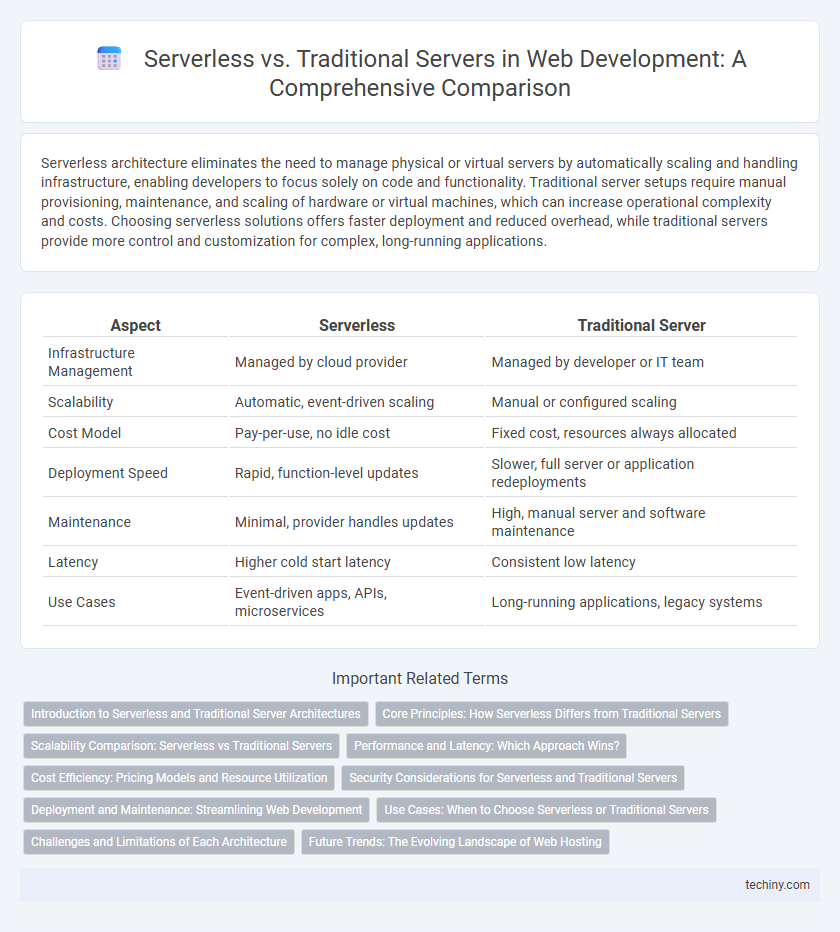Serverless architecture eliminates the need to manage physical or virtual servers by automatically scaling and handling infrastructure, enabling developers to focus solely on code and functionality. Traditional server setups require manual provisioning, maintenance, and scaling of hardware or virtual machines, which can increase operational complexity and costs. Choosing serverless solutions offers faster deployment and reduced overhead, while traditional servers provide more control and customization for complex, long-running applications.
Table of Comparison
| Aspect | Serverless | Traditional Server |
|---|---|---|
| Infrastructure Management | Managed by cloud provider | Managed by developer or IT team |
| Scalability | Automatic, event-driven scaling | Manual or configured scaling |
| Cost Model | Pay-per-use, no idle cost | Fixed cost, resources always allocated |
| Deployment Speed | Rapid, function-level updates | Slower, full server or application redeployments |
| Maintenance | Minimal, provider handles updates | High, manual server and software maintenance |
| Latency | Higher cold start latency | Consistent low latency |
| Use Cases | Event-driven apps, APIs, microservices | Long-running applications, legacy systems |
Introduction to Serverless and Traditional Server Architectures
Serverless architecture eliminates the need to manage physical servers by running code on cloud providers' infrastructure, automatically scaling resources based on demand and reducing operational overhead. Traditional server architectures require dedicated or virtual servers managed by developers, involving manual configuration, scaling, and maintenance tasks to ensure application availability. Serverless models offer event-driven execution and pay-per-use billing, whereas traditional servers incur fixed costs regardless of usage.
Core Principles: How Serverless Differs from Traditional Servers
Serverless architecture eliminates the need for server management by abstracting infrastructure, enabling automatic scaling and event-driven execution, unlike traditional servers which require dedicated resources and manual configuration. In traditional setups, applications run on fixed servers, often leading to over-provisioning or underutilization, whereas serverless platforms allocate compute resources dynamically based on real-time demand. This core principle shift reduces operational overhead, enhances cost-efficiency, and accelerates deployment cycles in web development.
Scalability Comparison: Serverless vs Traditional Servers
Serverless architecture offers automatic scaling based on demand, instantly allocating resources without manual intervention, which contrasts with traditional servers that require pre-configured capacity and manual scaling adjustments. Traditional servers often lead to resource underutilization or overprovisioning during traffic fluctuations, whereas serverless environments efficiently handle variable loads with fine-grained scalability. This dynamic scalability in serverless platforms reduces costs and improves performance by matching resources precisely to the workload.
Performance and Latency: Which Approach Wins?
Serverless architecture reduces latency by dynamically allocating resources, leading to faster response times compared to traditional servers with fixed hardware capacity. Traditional servers often experience performance bottlenecks during traffic spikes due to limited scalability, whereas serverless platforms automatically scale, ensuring consistent low latency. However, cold start delays in serverless functions can occasionally increase latency, making traditional servers more reliable for predictable workloads.
Cost Efficiency: Pricing Models and Resource Utilization
Serverless architecture offers a pay-as-you-go pricing model, charging only for the exact compute time and resources consumed, leading to cost savings compared to traditional servers that require paying for fixed capacity regardless of usage. Traditional servers involve expenses such as provisioning, maintenance, and idle resource costs, which reduce overall cost efficiency when demand fluctuates. Efficient resource utilization in serverless computing minimizes waste and aligns costs dynamically with actual workload, optimizing budget allocation for web development projects.
Security Considerations for Serverless and Traditional Servers
Serverless architecture reduces the attack surface by abstracting server management, automatically applying patches, and isolating functions, which enhances security through built-in vendor protections. Traditional servers require manual maintenance, patching, and configuration, increasing the risk of vulnerabilities due to human error and outdated software. Despite serverless benefits, concerns such as shared tenancy, complex permission management, and cold start vulnerabilities necessitate vigilant security practices and continuous monitoring.
Deployment and Maintenance: Streamlining Web Development
Serverless architecture eliminates the need for manual server management, allowing developers to deploy applications quickly via cloud platforms like AWS Lambda or Azure Functions. Traditional server setups require configuring and maintaining physical or virtual servers, increasing deployment complexity and ongoing maintenance efforts. Streamlining web development through serverless models results in faster time-to-market and reduced operational overhead.
Use Cases: When to Choose Serverless or Traditional Servers
Serverless architecture excels in applications with unpredictable traffic patterns, rapid development cycles, and event-driven processes, such as microservices, mobile backends, and real-time data processing. Traditional servers are preferable for workloads requiring consistent, long-running processes, custom configurations, or legacy application support, including enterprise software and monolithic applications. Choosing between serverless and traditional servers depends on factors like scalability needs, cost efficiency, and infrastructure management preferences.
Challenges and Limitations of Each Architecture
Serverless architecture faces challenges such as cold start latency, vendor lock-in, and limited control over server environment, impacting performance and customization. Traditional server setups offer greater control and consistent performance but involve higher maintenance costs, complex scaling, and infrastructure management overhead. Both architectures require careful consideration of security, cost optimization, and application-specific requirements to balance efficiency and flexibility in web development.
Future Trends: The Evolving Landscape of Web Hosting
Serverless architecture is shaping the future of web hosting by enabling auto-scaling, reducing infrastructure management, and optimizing cost efficiency compared to traditional server models. Emerging trends highlight the integration of edge computing and Function-as-a-Service (FaaS) platforms, driving faster content delivery and improved latency. As cloud providers enhance serverless offerings, businesses increasingly adopt hybrid models that combine traditional servers with serverless functions for flexibility and resilience.
Serverless vs Traditional Server Infographic

 techiny.com
techiny.com